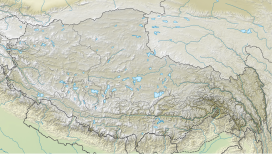| Labuche Kang | |
|---|---|
 Labuche Kang (Centre) and Shishapangma (left) as seen from Cho Oyu Labuche Kang (Centre) and Shishapangma (left) as seen from Cho Oyu | |
| Highest point | |
| Elevation | 7,367 m (24,170 ft) Ranked 75th |
| Prominence | 1,957 m (6,421 ft) |
| Listing | Ultra |
| Coordinates | 28°18′15″N 86°21′03″E / 28.30417°N 86.35083°E / 28.30417; 86.35083 |
| Geography | |
 | |
| Country | China |
| Region | Tibet |
| Parent range | Labuche Himal, Himalaya |
| Climbing | |
| First ascent | October 26, 1987 by A. Deuchi, H. Furukawa, K. Sudo (Japanese); Diaqiog, Gyala, Lhaji, Wanjia (Chinese) |
| Easiest route | West Ridge: glacier/snow climb |
Labuche Kang (or Lapche Kang, Lobuche Kang I, Choksiam) is a northern outlier of the Himalayas inside Tibet. It rises northwest of Rolwaling Himal and east of Shishapangma. The peak belongs to a little-known section of the Himalaya variously called Labuche Himal, Pamari Himal and Lapchi Kang that extends from the valley of the Tamakosi River west to the valley of the Sun Kosi and Nyalam Tong La pass where Arniko-Friendship Highway cross the Himalaya. This section extends south into Nepal east of Arniko Highway. It is wholly within the catchment of the Kosi, a Ganges tributary.
Labuche Kang was first climbed in 1987 by a Sino-Japanese expedition, via the West Ridge. No other attempts are recorded until September 2010 when American climber Joe Puryear fell to his death during an unsuccessful attempt.
See also
[REDACTED] Media related to Labuche Himal at Wikimedia Commons
References
- ^ "China I: Tibet - Xizang". Peaklist.org. Retrieved 2014-05-30.
- Carter, H. Adams (1985). "Classification of the Himalaya" (PDF). American Alpine Journal. 27 (59). American Alpine Club: 122. Retrieved May 1, 2011.
- "Himalayan Index". London: Alpine Club. Retrieved May 18, 2011.
- Puryear's accident Archived 2010-10-31 at the Wayback Machine
This Tibet location article is a stub. You can help Misplaced Pages by expanding it. |